Research - Ponnurangam Lab
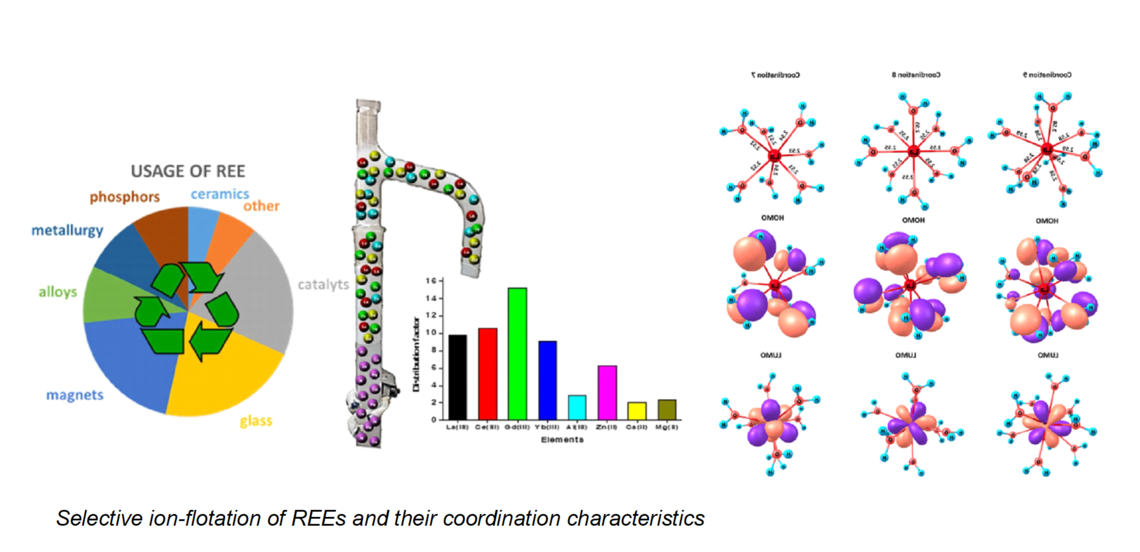
Sustainable Resource Extraction
Vanadium (for redox flow batteries), lithium (in batteries), and rare earth elements (REE, for the high-tech sector) are strategic/critical metals. The extraction and selective separation of these valuable elements from low-grade ore bodies (shale) and ultra-dilute secondary resources (blast furnace slag, vacuum residue, tailings, petcoke, and formation water) remains an unresolved challenge. The state-of-art technology for the release of these metals from their matrices involves some form of chemical roasting at high temperatures (typically 800+°C), which is an energy and material-intensive approach and requires high capital investments. Our research explores the suitability of the efficient leaching of metal ions from different feedstocks through optimization of the energy-expensive roasting step as well as selectively purifying metal ions from other gangue ions. We have developed alternative greener methods for purifying valuable metals from leachates. One such approach is based on utilizing a bio-based and cheap adsorbent (functionalized cellulose). Through this approach, we have achieved high selectivity for vanadium and rare earth elements over nickel, copper, chromium, and iron in the lab. We have also demonstrated the use of greener reagents such as monorhamnolipids for selective ion flotation of REEs as opposed to commonly found gangue ions. Currently, we are developing polymer nanocomposites that can selectively enrich lithium ions present in dilute concentrations (~75 ppm) in formation waters as opposed to other alkali and alkaline earth metal ions present in very high concentrations.
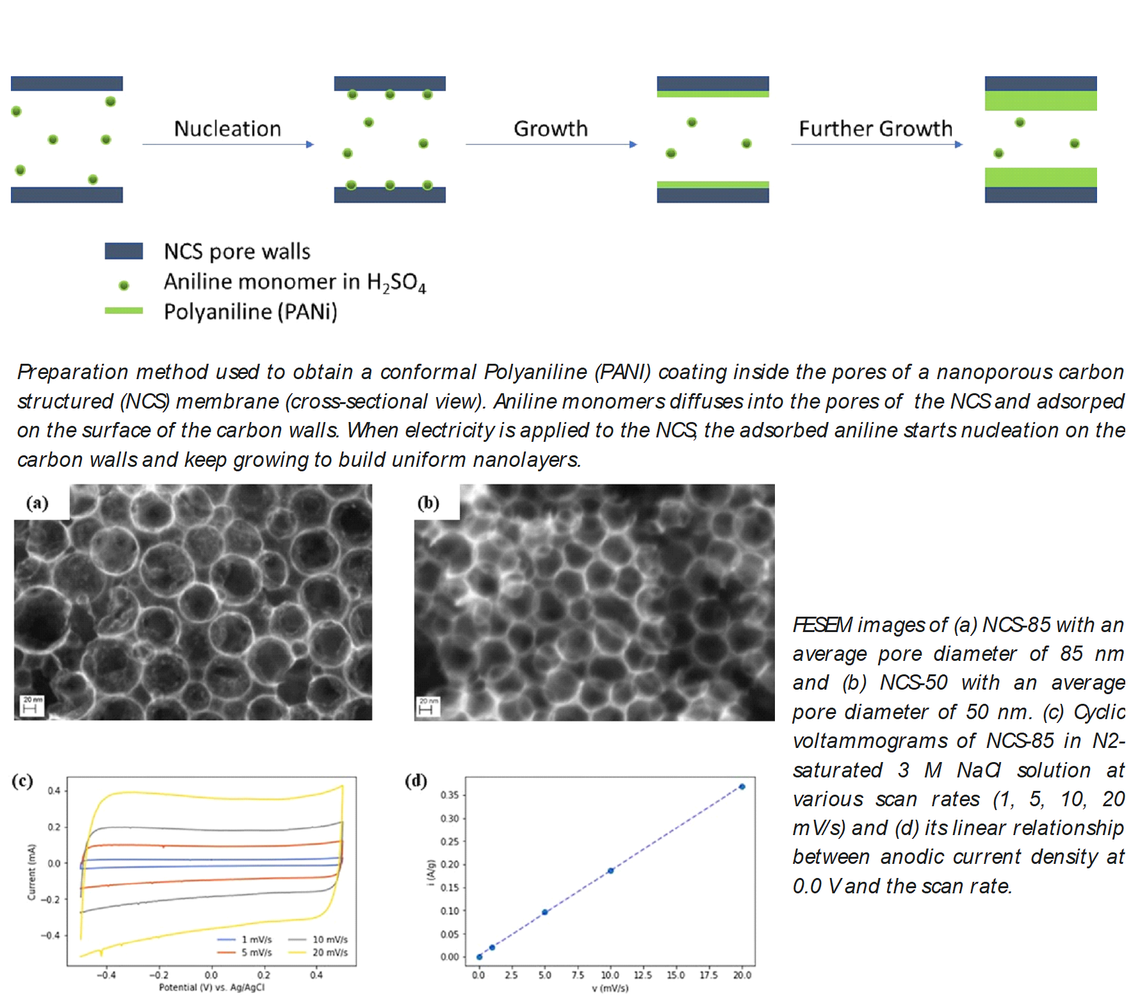
Advanced Electrochemical Water Treatment and Soil Remediation methods
Capacitive deionization (CDI) has emerged as a promising new technology for the production of clean water from brackish or even seawater at high efficiency and at low cost, also showing promise in storing energy while simultaneously achieving desalination. Our group is developing electrochemically-based methods for water desalination and recovery of valuable elements. In collaboration with Profs. Birss and Chernyshova, we have developed metal-free recyclable electrosorbents and capacitive electrodes based on conducting polymers and nanocarbon. The performance of these electrodes is better than their carbon analogs. Also, the electrochemical suite of technologies offers benign and in situ pathways for eliminating contaminants from a wide variety of polluted soils (including difficult-to-treat fine clays). In our group, an electrokinetic solution in combination with CDI is being developed to treat salt- and hydrocarbon-contaminated soils that are abandoned after oil-field operations. A key advantage of our approach is its non-invasiveness and modularity which results in a significant reduction in soil handling costs as well as an ability to apply to a wider contaminated area.
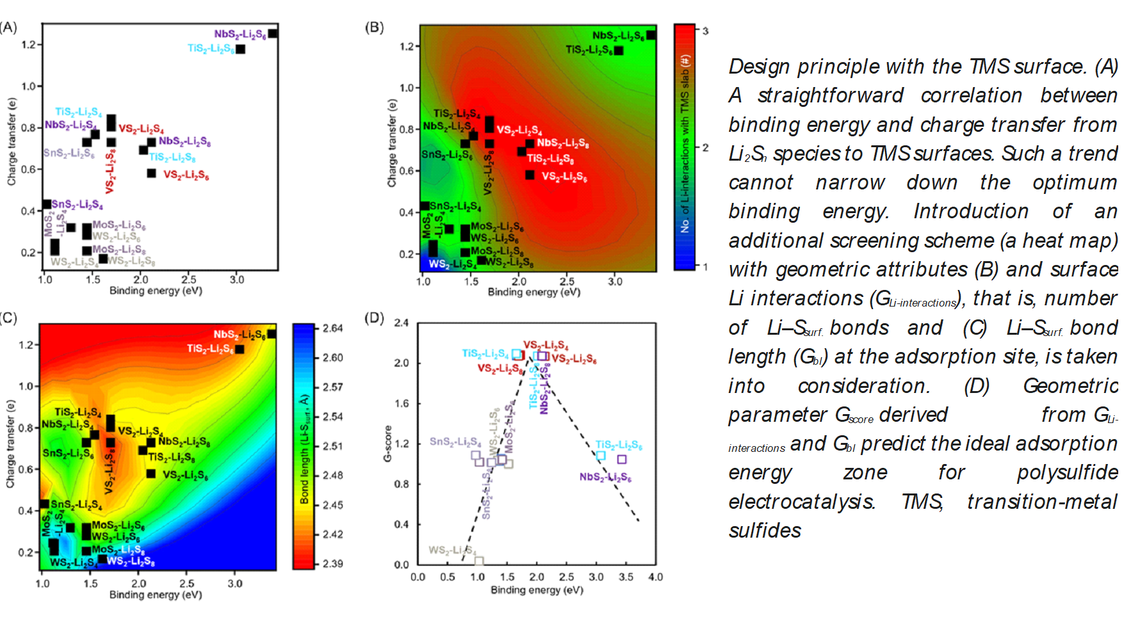
Screening of battery materials
Advanced battery materials research is geared towards identifying materials and their assemblies that demonstrate energy density higher than that of conventional Li-ion batteries. The energy densities of Li-ion systems are limited by intercalation chemistry at the cathode. Recently, our collaborators in Chemistry department (Dr. Thangadurai’s group) have developed a high energy density system (a novel Li - MoS3 electrode with discharge capacity of ~ 1000 mAh/g). Using density functional theory simulations (DFT), our group has clarified the mechanisms by which such enhancement occurs. Our ongoing collaboration is focused on, using DFT, screening (1) various layered sulfides to identify their thermodynamic potential window (stability studies) and (2) solid electrolytes based on ternary mixed-oxide and to identify optimal compositions which result in excellent stability under high applied potential (e.g., > 8 V).
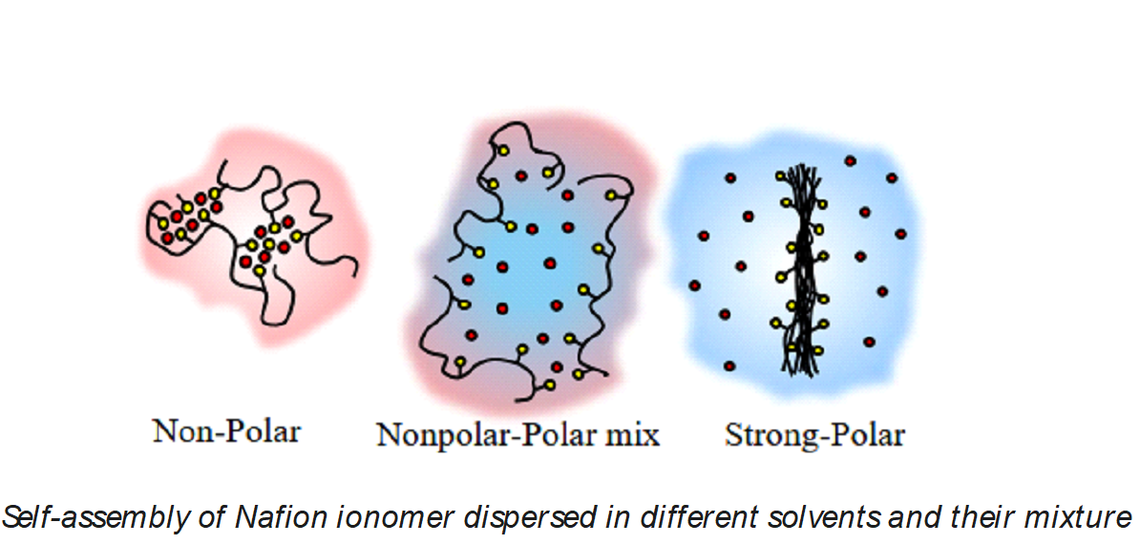
Molecular Assemblies in Fuel Cell Systems
Improving transport across ionomer membranes in polymer fuel cells and Li-ion batteries. A theory-based understanding of ionomer aggregation in different solvents as well as ionomer self-assembly in solid-state is crucial for transitioning from the empirically guided fabrication of high-performance electrodes of fuel cells and other electrochemical devices. Considering Nafion as a model ionomer, our collaborative research (Dr. Karan) has reshaped the long-held view of Nafion aggregate structures as elongated cylinder-like aggregates. We have found a variety of structures, along with evidence of the formation of ion-pair clusters. These results have elucidated that aggregation of ionomers, unlike non-ionic macromolecules, expectedly, is dominated by strong electrostatic interactions, and thereby solvent dielectric constant and counter-ion type play crucial roles. Using a similar approach, we have demonstrated differences in the dispersion behavior of nanoparticles in polymer nanocomposites with or without surface functionalization.
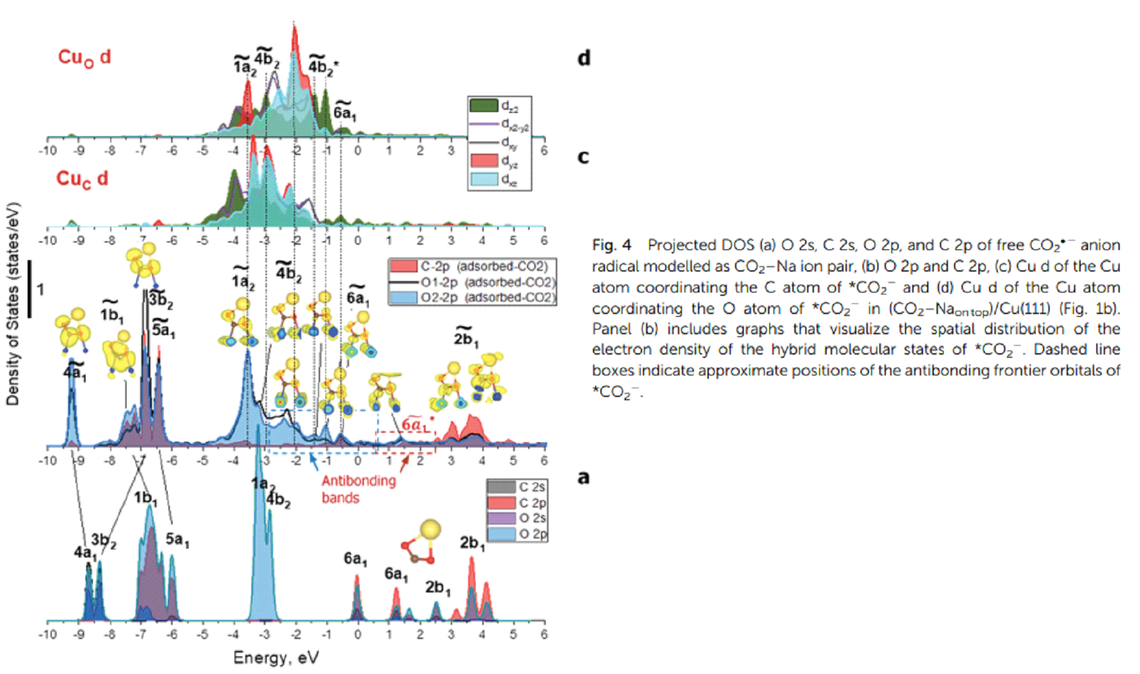
Electrocatalytic conversion of CO2
Low-Temperature Conversion of CO2 into Fuels: Electrocatalytic conversion of CO2 into specialty chemicals or fuels using renewable energy is a very promising approach to reduce our carbon footprint and our dependence on fossil fuels. There are several key challenges that prevent widespread commercialization of this technology. These include (a) low energy efficiency of CO2 conversion (large overpotentials), (b) poor products selectivity – most common products include a mixture of CO, HCOOH, and H2, (c) catalyst poisoning, and (d) sluggish kinetics (low current). Towards solving these challenges, we use a combination strategy of bench-scale electrolyzer development, spectroscopic characterization, and DFT-based modeling methods. In particular, to improve the robustness of the electrocatalysts, our group is developing nanocomposite electrodes with (conducting) polymers. Further efforts are ongoing in our group to develop gas-diffusion systems based on these electrodes (adapting a fuel cell configuration through collaboration with Prof. Karan’s group). The spectroscopic characterization and DFT modeling work are geared towards elucidating the role of CO2 intermediates as well as the effect of applied electric field on electrocatalysis pathways. This is expected to accelerate the discovery of durable and selective CO2 electroreduction catalysts.
High Temperature Conversion of CO2 into Fuels: Conversion of CO2 to syngas can be achieved in solid oxide electrolysis cells at high temperatures (~1000 K) using perovskite-based solid oxides as electrocatalysts. This process is projected to be among the most viable ways of generating fuels from CO2. Using DFT calculations and reactive molecular dynamics (in-house developed reactive forcefields), we study the electronic structure and stability of perovskite-based solid oxides used as electrocatalysts for CO2 conversion. The effect of high temperatures and applied electric field is investigated, as well as the time evolution of reactions involving CO2 on the surface of slabs from the perovskites.
Methodology
In the above projects, the performance of the complex systems are controlled by the colloid and surface chemistry and physics of complex and (electrified) heterogeneous systems (e.g., catalysts, sorbents, and mineral matrices of different origin). Therefore, to accelerate the technology development, research in our group is focused on a better understanding of this chemistry and physics through combining advanced experimental methods with theoretical modelling. The experimental methods include bench-scale electrochemical and interfacial characterizations, operando spectroscopy, electrochemical microscopy with Kelvin probe, X-ray photoelectron spectroscopy, and NMR. The theoretical modelling methods include quantum chemical (Density Functional Theory, DFT) and classical and reactive molecular simulation methods.
Publications
https://scholar.google.com/citations?user=4XGbTQkAAAAJ&hl=en&oi=ao
Edited Books and Book Chapters:
|
Multidisciplinary Advances in Efficient Separation Processes IV Chernyshova, S Ponnurangam, Q Liu American Chemical Society |
2020 |
|
I Chernyshova, D Bakuska, S Ponnurangam Multidisciplinary Advances in Efficient Separation Processes, 115-165 |
2020 |
|
Progress in Capacitive Deionization for Desalination of Brackish Water: A Materials Perspective C Ai, S Ponnurangam Multidisciplinary Advances in Efficient Separation Processes, 91-113 |
2020 |
|
Metal Electrodes: CO2 Reduction Interfacial Processes S Ponnurangam, I Chernyshova, P Somasundaran Encyclopedia of Surface and Colloid Science, Third Edition, 4148-4161 |
2015 |
|
Nanoparticles: size dependency and electrochemical properties IV Chernyshova, S Ponnurangam, P Somasundaran Encyclopedia of surface and colloid science. Boca Raton: CRC Press, Taylor … |
2015 |
Journal Publications:
|
AM Abraham, K Thiel, M Shakouri, Q Xiao, A Paterson, J Schwenzel, ... Advanced Energy Materials, 2201494 |
2022 |
|
P Karimi, A Alihosseinzadeh, S Ponnurangam, K Karan Journal of The Electrochemical Society |
2022 |
|
NM Rasi, S Ponnurangam, N Mahinpey Catalysis Today |
2022 |
|
NM Rasi, A Karcz, S Ponnurangam, N Mahinpey Catalysis Today |
2022 |
|
AM Abraham, T Boteju, S Ponnurangam, V Thangadurai Battery Energy, 20220003 |
2022 |
|
C Ai, IV Chernyshova, EL Gawron, S Ponnurangam, VI Birss Journal of Materials Chemistry C 10 (6), 2271-2280 |
2022 |
|
AM Abraham, S Ponnurangam, V Thangadurai Inorganic Chemistry 60 (17), 12883-12892 |
2021 |
|
JC Mora, YCM Nederstigt, JM Hill, S Ponnurangam The Journal of Physical Chemistry C 125 (26), 14299-14310 |
2021 |
|
A Mitra, M Trifkovic, S Ponnurangam Macromolecules 54 (9), 3962-3971 |
2021 |
|
NM Rasi, AS Hyla, S Ponnurangam, N Mahinpey Physical Chemistry Chemical Physics 23 (22), 12795-12806 |
2021 |
|
Foam flotation of rare earth elements by conventional and green surfactants S Shetty, IV Chernyshova, S Ponnurangam Minerals Engineering 158, 106585 |
2020 |
|
MS Capper, A Enriquez Garcia, N Macia, B Lai, JB Lin, M Nomura, ... JBIC Journal of Biological Inorganic Chemistry 25 (5), 759-776 |
2020 |
|
I Chernyshova, D Bakuska, S Ponnurangam Multidisciplinary Advances in Efficient Separation Processes, 115-165 |
2020 |
|
Progress in Capacitive Deionization for Desalination of Brackish Water: A Materials Perspective C Ai, S Ponnurangam Multidisciplinary Advances in Efficient Separation Processes, 91-113 |
2020 |
|
Multidisciplinary Advances in Efficient Separation Processes IV Chernyshova, S Ponnurangam, Q Liu American Chemical Society |
2020 |
|
A Tarokh, K Karan, S Ponnurangam Macromolecules 53 (1), 288-301 |
2019 |
|
A Mammoottil Abraham, SP Kammampata, S Ponnurangam, ... ACS applied materials & interfaces 11 (39), 35729-35737 |
2019 |
|
IV Chernyshova, S Ponnurangam Physical Chemistry Chemical Physics 21 (17), 8797-8807 |
2019 |
|
Z Dubrawski, J Heidebrecht, BMP Lombardi, AS Hyla, J Willkomm, ... Sustainable Energy & Fuels 3 (5), 1172-1181 |
2019 |
|
On the origin of the elusive first intermediate of CO2 electroreduction IV Chernyshova, P Somasundaran, S Ponnurangam Proceedings of the National Academy of Sciences 115 (40), E9261-E9270 |
2018 |
|
Nitrogen-containing polymers as a platform for CO2 electroreduction S Ponnurangam, IV Chernyshova, P Somasundaran Advances in colloid and interface science 244, 184-198 |
2017 |
|
Catalytic synthesis of mixed alcohols mediated with nano-MoS2 microemulsions JK Hasty, S Ponnurangam, S Turn, P Somasundaran, T Kim, D Mahajan Fuel 164, 339-346 |
2016 |
|
Robust Electroreduction of CO2 at a Poly(4‐vinylpyridine)–Copper Electrode S Ponnurangam, CM Yun, IV Chernyshova ChemElectroChem 3 (1), 74-82 |
2016 |
|
Biocompatibility of polysebacic anhydride microparticles with chondrocytes in engineered cartilage S Ponnurangam, GD O’Connell, CT Hung, P Somasundaran Colloids and Surfaces B: Biointerfaces 136, 207-213 |
2015 |
|
Metal Electrodes: CO2 Reduction Interfacial Processes S Ponnurangam, I Chernyshova, P Somasundaran Encyclopedia of Surface and Colloid Science, Third Edition, 4148-4161 |
2015 |
|
Nanoparticles: size dependency and electrochemical properties IV Chernyshova, S Ponnurangam, P Somasundaran Encyclopedia of surface and colloid science. Boca Raton: CRC Press, Taylor … |
2015 |
|
S Ponnurangam, GD O'Connell, IV Chernyshova, K Wood, CTH Hung, ... Tissue Engineering Part A 20 (21-22), 2908-2919 |
2014 |
|
A Vilinska, S Ponnurangam, I Chernyshova, P Somasundaran, D Eroglu, ... Journal of colloid and interface science 423, 48-53 |
2014 |
|
IV Chernyshova, S Ponnurangam, P Somasundaran Physical Chemistry Chemical Physics 15 (18), 6953-6964 |
2013 |
|
S Ponnurangam, IV Chernyshova, P Somasundaran Langmuir 28 (29), 10661-10671 |
2012 |
|
B Rai, P Sathish, J Tanwar, KS Moon, DW Fuerstenau Journal of Colloid and Interface Science 362 (2), 510-516 |
2011 |
|
Adsorption of fatty acids on iron (hydr) oxides from aqueous solutions IV Chernyshova, S Ponnurangam, P Somasundaran Langmuir 27 (16), 10007-10018 |
2011 |
|
Effect of nanosize on catalytic properties of ferric (hydr) oxides in water: Mechanistic insights IV Chernyshova, S Ponnurangam, P Somasundaran Journal of catalysis 282 (1), 25-34 |
2011 |
|
IV Chernyshova, S Ponnurangam, P Somasundaran Journal of the American Chemical Society 133 (24), 9536-9544 |
2011 |
|
Effect of coadsorption of electrolyte ions on the stability of inner-sphere complexes S Ponnurangam, IV Chernyshova, P Somasundaran The Journal of Physical Chemistry C 114 (39), 16517-16524 |
2010 |
|
Nanoparticles: characteristics, mechanisms and modulation of biotoxicity P Somasundaran, X Fang, S Ponnurangam, B Li KONA powder and particle journal 28, 38-49 |
2010 |
|
IV Chernyshova, S Ponnurangam, P Somasundaran Physical Chemistry Chemical Physics 12 (42), 14045-14056 |
2010 |
|
Fluoride-containing hydraulic cements and methods of making the same B Rai, S Ponnurangam, P Kapur, A Unal, R Cahill, J Norton, J Stenack, ... US Patent App. 11/835,076 |
2008 |
|
Effect of alcohol and polyglycol ether frothers on foam stability, bubble size and coal flotation AK Gupta, PK Banerjee, A Mishra, P Satish International Journal of Mineral Processing 82 (3), 126-137 |
2007 |
|
Molecular dynamic simulations of self-assembled alkylthiolate monolayers on an Au (111) surface B Rai, P Sathish, CP Malhotra, Pradip,*,† and, KG Ayappa Langmuir 20 (8), 3138-3144 |
2004 |
|
PB RAI, P Sathish, S Krishnamurty Ferroelectrics 306 (1), 195-208 |
2004 |
|
Rational design of dispersants by molecular modeling for advanced ceramics processing applications B Rai, P Sathish KONA Powder and Particle Journal 22, 151-158 |
2004 |
